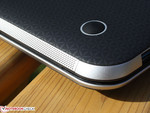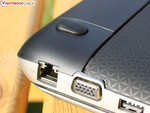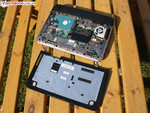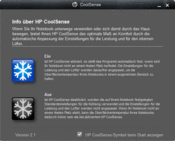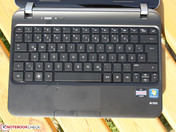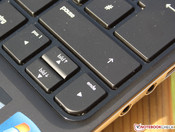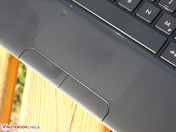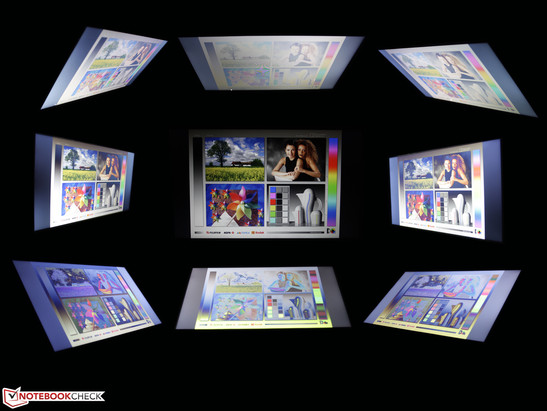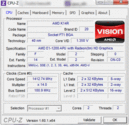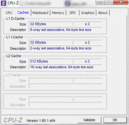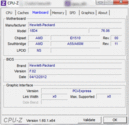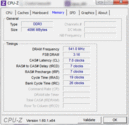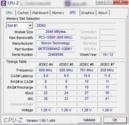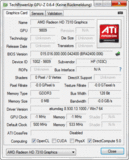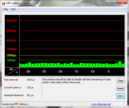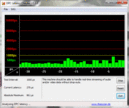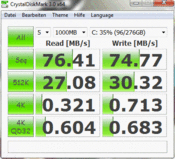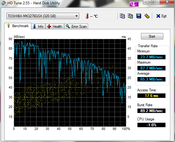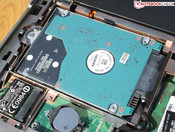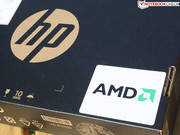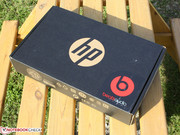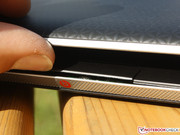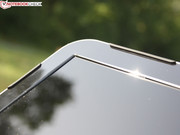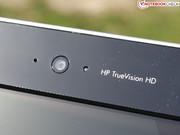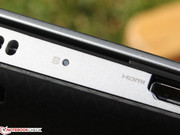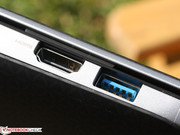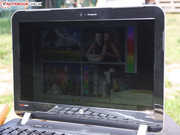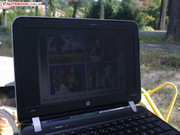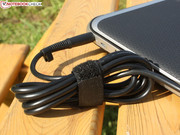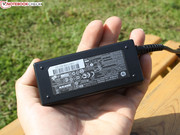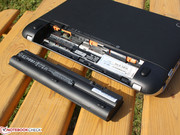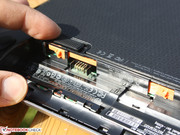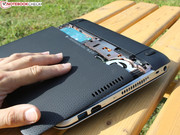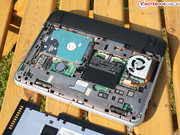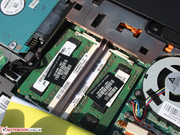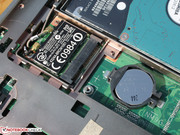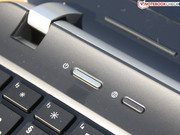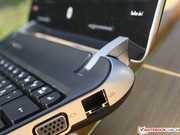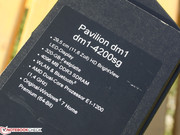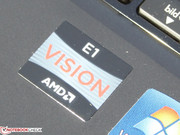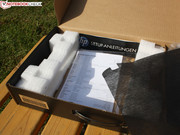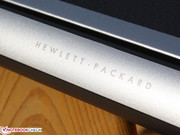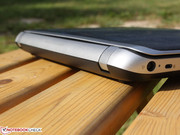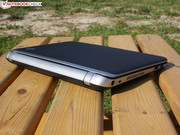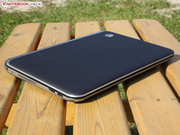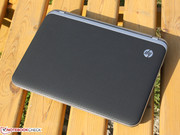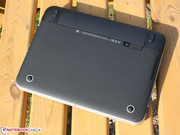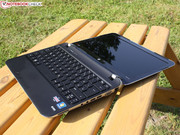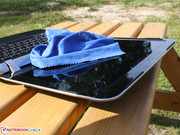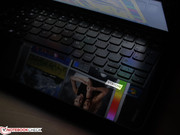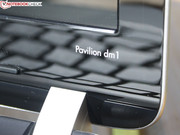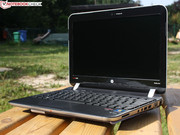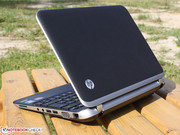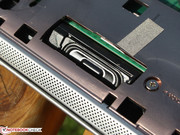Review HP Pavilion dm1-4200sg Netbook

Those who do not want to spend more than 400 Euros for a mobile PC should not consider the more expensive ultrabooks, but rather the netbooks and subnotebooks with Intel or AMD processors. Recent 11.6-inch devices for this price-conscious target group included the Acers Aspire One 756 (Pentium ULV), the Aspire One D270-26Dbb (Atom N2600), the Aspire One 722-C62kk (AMD C-60), the Samsung 305U1A-A01DE (E-450), the Sony Vaio SVE-1111M1E/P and the Lenovo ThinkPad X121e (AMD E-300). The future has more of these in store, as the Lenovo ThinkPad Edge E130 (Pentium 977), IdeaPad S206 (E1-1200) or the ThinkPad Edge E135 (E2-1800) show us (reviews will follow soon).
Intel's Atom processors, which powered the classic netbooks from 2008 to 2010, could not assert themselves over AMD's APU platforms. With better multimedia qualities and somewhat higher performance, the APU devices managed at least as long battery runtimes as Intel's Atom.
HP decided to use an AMD E1-1200 (2 x 1.40 GHz) for the new version of its Pavilion dm1-4200sg (B6K79EA). The APU rounds up the current E series at the bottom. It does in fact have a lower performance than the sister APU E2-1800, but with an 11.6-inch netbook more important is the mobility. How does the small guy perform, you can read in our detailed review.
Case
HP does not follow the mass trend of super flat subnotebooks and has built a device that stresses its bulkiness at the rear area. The notebook uses its 32 mm (1.25 inches) height in order to house the removable battery. In comparison to many ultrabooks and even some low-cost minis (Lenovo S206), the removable battery seems almost a rarity.
Rarely is the width of the opening angle of the display lid exactly 180 degrees. Thus we can open the display all the way to the table top. The high weight of 1.5 kg is partially due to the 55 Wh battery. The rest stems from the plastic housing, which is rubberized on the lid to give it higher grip.
The hinges are tightly and firmly mounted on the base unit. The silver cover gives in significantly when pressed. The display lid also gives in, even under light pressure. All this does not hinder functionality, but it takes away from the value.
Simple maintenance and quick replacement of components seems to be of great importance to HP. Thus the bottom cover lacks any screws and it can simply be slid to the front. This not only exposes the components, but also allows for cleaning the fan.
Unfortunately the dm1-4200sg trumps these advantages with the weak stability of the chassis as well as inaccurate gaps on the bottom side. We even had a problem with the bottom cover pushing itself open when we handled the device. A couple of screws could have worked wonders here. The base unit bends significantly if we lift it at a front corner.
Connectivity
HDMI, USB 3.0, VGA and audio jacks. All the necessary is on board of this 11.6-inch notebook. The competition does not offer anything more in this price range either. On the contrary, USB 3.0 is not always standard and sometimes even Ethernet and VGA are omitted (Lenovo Ideapad S206).
Connectivity
HDMI, USB 3.0, VGA and audio jacks. All the necessary is on board of this 11.6-inch notebook. The competition does not offer anything more in this price range either. On the contrary, USB 3.0 is not always standard and sometimes even Ethernet and VGA are omitted (Lenovo Ideapad S206).
Communication
Gigabit Ethernet and Draft-N WLAN have now become standard and can also be found in the HP. New is the Broadcom Bluetooth 4.0+HS module. The 1.3 MP webcam takes photos in an acceptable resolution and quality. We like the natural colors. The focus could have been a bit better, but it is more than enough for snapshots and video chat.
Maintenance
The removable bottom cover provides for upgrade options. Our device comes with 2 x 2 GB system memory. The WLAN module and the hard drive can be reached as quickly as the CMOS battery can. The fan can also be cleaned.
Accessories
HP does not supply any disks in the box, just a quick start guide for the absolute beginners. A system recovery DVD can be written via the HP Recovery Manager. For that you would need a USB DVD burner. The pre-installed software is limited: Office Starter, Windows Live Essentials and Norton Internet Security (60 days) seem to be a kind of a standard for notebooks. HP-specific tools are the Beats Audio (Equalizer, noise reduction) and Cool Sense (fan control).
Warranty
The warranty is limited to 12 months bring-in, where the customer covers the postage. Care Packs for 3-year next business on-site service costs 160 Euros (~$210). Cheaper is the 3-year pick-up and delivery service for 80 Euros (~$105). The price-conscious customer would not mind spending that kind of money for such services.
Input Devices
Keyboard
The keys have a long key drop; the pressure point is unfortunately somewhat unclear. The click sound and stroke are soft and quiet. The keyboard area is firm. The typing experience on the spacious layout is smooth and fun. Despite the flat keys, the accuracy is high. Note here the full use of the space for left to the right edge and the large Enter, Backspace, and Shift.
A good idea is the luminous Caps Lock and WLAN key. A tiny LED is located there. Thus if someone is angry about sudden capital letters or no internet, the culprit is immediately found.
Touchpad
The mouse here is a Multi-touch Pad (Synaptics V7.5). The surface of the pad is at the level of the palm rest. Small nubs differentiate the two areas. The nub structure gives a pleasantly rough feedback and is easy to get used to. The touch pad only has a vertical scrollbar (optically not marked, can be activated). The horizontal one is lacking, but this is easily replaced by two fingers.
The buttons click loudly and have a short stroke. Good keys, which serve for a fast use, would have the opposite qualities. The touch pad does not come close to the ones found in HP ProBooks and EliteBooks. The touch pad can be turned off via a small recess (double click) in the top left corner. The LED above lights up as a reminder.
Display
The 11.6-inch display by Samsung has a resolution of 1366x768 pixels. This resolution has been the standard in this form factor for quite some time now and HP does not offer any alternatives for the dm1. The panel is not matte. The glare type of display is common in this price range, yet notebooks like the Lenovo ThinkPad Edge E130/E135, Samsung 305U1A, ASUS Zenbook Prime UX21A-K1010V or TravelMate B113-M also offer a matte screen.
The measured contrast ratio is only 137:1, which is extremely low. Blacks look quite pale and the colors are not vivid. The glare screen somewhat "polishes" these drawbacks optically.
| |||||||||||||||||||||||||
Brightness Distribution: 73 %
Center on Battery: 210 cd/m²
Contrast: 137:1 (Black: 1.53 cd/m²)
40.39% AdobeRGB 1998 (Argyll 3D)
58.5% sRGB (Argyll 3D)
39.05% Display P3 (Argyll 3D)
A high color space coverage is important only for the professional graphics and image editors. So the fact that it does not cover AdobeRGB and sRGB is not particularly relevant. Other devices in this class do not offer more, as the comparison with the Aspire One 756 in the third picture shows. In a more expensive device, the manufacturers use better IPS panels, such as in the Asus UX31A (last picture).
The brightness of the display is 198 cd/m², which suffices for indoor use, but is not enough to compensate for the reflection outside. Even with a matte panel, we would ideally want 250 cd/m², in order to view the desktop easily, so whilst checking your e-mails with coffee and cake, you would find yourself disturbed by reflections. The desktop is more or less shrouded in darkness under bright daylight.
The LED backlit panel has poor brightness distribution. This leads to the average illumination of 73%. Lighter or darker spots however, are not visible with the naked eye.
The small viewing angle brings the Samsung panel more negative points. Horizontally at about 50 degrees these are significant. Vertically at 10 degrees we start seeing undesirable distortions. Larger viewing angles are desirable for any application, but cannot really be expected from small netbooks and subnotebooks in this price range.
Performance
HP has equipped the 11.6-incher with a dual-core APU by AMD. The Accelerated Processing Unit is a processor with integrated graphics card and single-channel memory controller (up to DDR3-1066). The Bobcat core of the E1-1200 (2 x 1.4 GHz) are relatively weak. But because of their low power consumption, the APU allows for long runtimes. A "power version" of the dm1 with AMD E2-1800 (2 x 1.7 GHz) is not available at this time.
The Radeon HD 7310 graphics in the APU should cover the multimedia aspects of the system and aid the low performance of the CPU cores. Since its 3D performance is lower than that of the Radeon HD 7340 in the E2-1800, current games are out of the question. The GPU helps the processor considerably more with decoding HD movies or with applications, which use the hardware acceleration of the Radeon.
TDP is 18 W. There is no turbo mode, but the Bobcat down-clocks to 800 MHz in idle. There are also 4096 MB DDR3 system memory in the dm1 (2 x 2 GB). The 64 bit Windows 7 is pre-installed on the 320 GB HDD by Toshiba.
Processor
The AMD E1-1200 Zacate APU is intended as a direct rival to the Intel Atom generations. We compared its performance to the sister model E2-1800 (1.7 GHz) and the predecessors AMD E-450 and C-60. The Pentium 987 (Acer Aspire One 756, 11.6-inch) is also in the competition.
The Cinebench R11.5 64 Bit showed a Multi-Core test result of 0.53 points. An E2-1800 (0.66) manages up to 25% more. The same goes for the E-450, which depending on the system is 10 to 20% faster. Only the C-60 (0.45), which is the predecessor of the E1, is 15 to 20% slower. The Multi-Thread benchmark cannot be run on the Atom N2600/N2800. The Pentium 987 is practically the performance leader (+113% @Aspire One 756).
The Single-Core test has the same results: 0.28 versus 0.34 points (E2-1800, +20 %), respectively versus 0.33 points (E-450, +18%). The C-60 is slower (-25%). The Low-Voltage Pentium keeps its advantage at +111 %.
The CPU performance is also available on battery power. The R11.5 Multi showed the same result as when plugged in.
System Performance
The above CPU comparison shows that the old and new Bobcat cores differ marginally in terms of computing power and are overall considerably weaker than a low-voltage Pentium in a low-cost system like the Aspire One 756. Can the Radeon HD 7310 get a few more rating points? Here the hard drive and system memory also play a role.
The result is weak, but comparable to other APU systems: 878 points in PCMark 7 (965 @Vaio SVE-1111M1E/P; 982 @Lenovo G585-M8325GE; an E2-1800 = 10-12% better). The Acer Aspire One 756 with Pentium 987 (HD 2000) is 65% faster. Atom netbooks are on the down side with N2600 and N2800 (-20 to 30%, e.g. Asus Eee PC R052C).
The PCMark Vantage (2246 points) is no different. The AMD E2-1800 scored the same and the older E-450 is also in this range. The Pentium 987 in the Aspire is again better (+58%). The APU systems perform rather poorly in these benchmarks. This corresponds to the slow operating speed. Installing programs, playing an HD movie, and at the same time copying data; for that the customer should allocate a bit more time than we are used to with an Intel Core system.
| PCMark Vantage Result | 2246 points | |
| PCMark 7 Score | 878 points | |
Help | ||
Storage Devices
The Toshiba MK3276GSX (320 GB, 5400 U/Min) is a slow candidate in terms of transfer rates. 65 MB/s read rates (HD Tune) will make the owner of even a cheap SSD laugh. The HDD scores in PCMark Vantage (3259 points) and PCMark 7 (1458 points) are below average even for a 5400 rpm HDD. An SSD upgrade would do wonders for the system speed. See HDD/SSD Benchmark table in the FAQ section.
Graphics Card
The DirectX 11 capable Radeon HD 7310 is positioned just below the Radeon HD 7340 (E2-1800). It is no powerhouse, as the following graph shows. The Radeon measures with the old HD 3000 (Sandy Bridge) and the HD 2000 (Pentium 987) as long as the CPU does not play any role in the benchmark.
| 3DMark 2001SE Standard | 7258 points | |
| 3DMark 03 Standard | 4111 points | |
| 3DMark 05 Standard | 2585 points | |
| 3DMark 06 Standard Score | 1455 points | |
| 3DMark Vantage P Result | 504 points | |
| 3DMark 11 Performance | 195 points | |
Help | ||
| 3DMark 11 - 1280x720 Performance (sort by value) | |
| HP Pavilion dm1-4200sg | |
| Acer Aspire One 722-C62kk | |
| Sony Vaio SVE-1111M1E/P | |
| Samsung 305U1A-A01DE | |
| 3DMark 06 - 1280x1024 Standard Score AA:0x AF:0x (sort by value) | |
| HP Pavilion dm1-4200sg | |
| Acer Aspire One D270-26Dbb | |
| Acer Aspire One 722-C62kk | |
| Sony Vaio SVE-1111M1E/P | |
| Samsung 305U1A-A01DE | |
| Acer Aspire One 756 NU.SH0EG.007 | |
| Wortmann Terra 1450 II | |
Gaming Performance
There is no question about the gaming performance with this device, as the covered-in-red table shows. The 3DMark 06 and 11 above already say: on lower settings, the user is better off with a low-voltage Pentium. But as we mentioned before, the dm1 is meant as a gamer.
| low | med. | high | ultra | |
|---|---|---|---|---|
| Risen (2009) | 22.1 | 11.7 | ||
| Fifa 12 (2011) | 17 | 15.2 | ||
| Battlefield 3 (2011) | 7.8 | 6.4 | ||
| Anno 2070 (2011) | 23.8 | |||
| Mass Effect 3 (2012) | 12.8 |
Emissions
Noise Levels
When surfing the web or writing e-mails under low-load operation, the fan runs constantly at 30 to 32 dB(A). It never turns off, even in prolonged idling. During the stress test, with the Radeon HD 7310 and the E1-1200 under full load, the noise reached 44.6 dB(A). Rather more realistic is 39.5 dB(A), which we measured during the 3DMark 06. HP Cool Sense was active throughout the measurements. Turning the program off resulted in no change.
Noise level
| Idle |
| 30.4 / 32.2 / 32.2 dB(A) |
| HDD |
| 30.8 dB(A) |
| Load |
| 39.6 / 44.6 dB(A) |
 | ||
30 dB silent 40 dB(A) audible 50 dB(A) loud |
||
min: | ||
Temperature
Despite the constant operation of the fan, the base unit heats up significantly in normal use. An average 34 °C on the top and 38 °C on the bottom side will not burn your pants, but the surfaces feel considerably warm. However, things look different after an hour of stress testing. The point of the bottom cover near the fan reached 56 °C, a very high temperature.
We ran the stress test, with the processor and graphics card simultaneously under full load, in order to burden the cooling system to the maximum. The clock frequency remained at the constant 1.4 GHz. The highest temperature according to HWinfo was 88 °C.
(±) The maximum temperature on the upper side is 44.7 °C / 112 F, compared to the average of 33.1 °C / 92 F, ranging from 21.6 to 53.2 °C for the class Netbook.
(-) The bottom heats up to a maximum of 56.2 °C / 133 F, compared to the average of 36.6 °C / 98 F
(±) In idle usage, the average temperature for the upper side is 34.5 °C / 94 F, compared to the device average of 29.8 °C / 86 F.
(-) The palmrests and touchpad can get very hot to the touch with a maximum of 44.7 °C / 112.5 F.
(-) The average temperature of the palmrest area of similar devices was 29.3 °C / 84.7 F (-15.4 °C / -27.8 F).
Speakers
The small stereo speakers (at the front) give a loud and, in terms of the mids and highs, relatively balanced sound. The bass lacks completely, as the small diaphragms cannot reproduce it. The beats audio settings offer presets for the internal speakers, in-ear headphones, passive standard headphones, and the HDMI. Without these, the sound seems thin and weak. The volume is very good for an 11.6-incher.
External audio devices can be connected either via the HDMI, or the classic headphone jack. There is also a separate jack for the good old analog microphone. Many manufacturers rely on a combo jack, which hinders some uses.
Battery Life
Power Consumption
Depending on the form factor, previous APU subnotebooks with AMD’s E-350 and E-450 consumed 8 to 14 W in idle and 24 to 30 W under load. HP’s 11.6-inch notebook draws in idle 7.7 to 10.1 W. But even the APU predecessor Samsung 305U1A with E-450 could manage this (8 to 11.5 W).
Under load with the 3DMark 2006, the 11.6-inch notebook consumes 24 W; in the stress test it needed 31 W. This is also typical for the efficient E-450 and E2-1800 devices. Samsung 305U1A: 24 and 30 W, Vaio SVE-1111M1E/P: 25 and 30 W. The battery was already charged during the measurements. At first glance, the 65 W power supply seems oversized. But this way there are 25 W left for charging the battery, which can continue even under higher load.
| Off / Standby | |
| Idle | |
| Load |
|
Key:
min: | |
Battery Life
The 55 Wh lithium-ion battery ensures the expected hours of battery life. In idle the 11.6–incher lasted 8:48 hours. This is unrealistic though, because it used minimum brightness and inactive wireless modules.
In the WLAN test (script refreshes websites, some with video) we measured a time of 5:55 hours. The brightness was set at 150 cd/m² (one step darker). With this runtime the dm1 seems acceptable, but is not among the best: the Sony Vaio SVE-1111M1E/P (E2-1800) manages only 4:19 hours, but with a weaker 38 Wh battery. Even APU-based 15.6-inch notebooks, such as the Lenovo G585-M8325GE (48 Wh), last five hours. The previous APU C-60 in the Acer Aspire One 722-C62kk (48 Wh) managed 6:47 hours. With a weaker battery, the Atom N2600 netbook Asus Eee PC 1011CX (47 wh) lasted a full 8:49 hours.
After the test, the dm1 required a charging time of 2:01 hours (active device, no load). This is appropriate for this capacity.
Verdict
The HP Pavilion dm1-4200sg (B6K79EA) leaves a mixed impression. The mixed impression is not about the low performance, which is partially due to the system and is a sacrifice, which must be made in the name of long battery life and low power consumption. Even the non-existent gaming performance was predictable and will deter potential customers.
The mixed feelings about the Pavilion dm1-4200sg are based on the partially good and partially bad characteristics. Five hours of battery life are great – but not with a moderately bright glare type panel. Matte, non-slip surfaces are very practical – but the creaking, flexible chassis blocks any impression of quality. Typing is quick on the large keyboard and gliding is easy on the touch pad – but what function do the reflective TFT bezel and high-gloss key frame serve?
For us the HP Pavilion dm1-4200sg is a fundamentally good device, which cannot sustain its strengths. The 11.6-inch notebook would have looked quite different with a matte TFT and a stable base unit.




